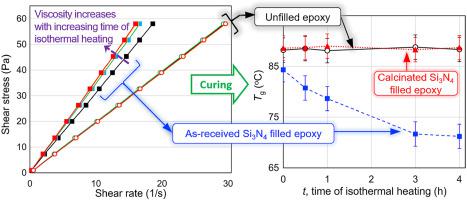Materials Today Chemistry ( IF 6.7 ) Pub Date : 2021-09-20 , DOI: 10.1016/j.mtchem.2021.100559 F.N. Alhabill 1 , A.S. Vaughan 2 , T. Andritsch 2

|
The interactions that occur between an amorphous silicon nitride (Si3N4) nanofiller and an epoxy matrix are examined, as revealed by rheological changes in a diglycidyl ether of bisphenol-A (DGEBA)-based epoxy resin prior to curing and thermal analysis, scanning electron microscopy, and dielectric spectroscopy of the resulting amine-cured systems. The results show that isothermally heating the as-received Si3N4 in DGEBA at 100 °C leads to increases in the viscosity of the mixture. Analysis of rheological data obtained from unfilled, as-received Si3N4-filled, and calcined Si3N4-filled epoxy systems leads us to interpret this increase in viscosity as arising from reactions between epoxide groups of the DGEBA and nanoparticle surface groups, notably involving surface amines, which are stimulated by the elevated temperature. The extent of this filler/resin reaction depends on the material processing protocol used, particularly prior calcination of the Si3N4 and the temperature and duration of nanoparticle/DGEBA mixing. Glass transition temperature data show that cured samples prepared using different methods have significantly different glass transition temperatures, which is a consequence of the epoxide/amine stoichiometric imbalances that result from prior reactions between the Si3N4 and the DGEBA. Consistent behavior was observed in the dielectric response. These results demonstrate that ultimate macroscopic properties of Si3N4/epoxy nanocomposites are critically affected by details of the processing protocol. Furthermore, we infer that, by using controlled prior calcination of the Si3N4, it is may be possible to vary the initial surface chemistry of the nanoparticles so as to adjust their reactivity with epoxy-containing moieties. Here, this is exemplified using only two somewhat extreme thermal treatments and a bifunctional DGEBA-type compound but, we suggest, that the concept may be extended to many other mono- and polyfunctional epoxy-containing compounds in order to generate a wide range of different grafted nanoparticle systems. This strategy may provide a versatile means of adjusting the surface chemistry of inorganic nitride nanoparticles, in order to tailor their surface chemistry and thereby modify resulting nanocomposite properties.
中文翻译:

关于纳米复合材料的制造:使用流变学表征环氧树脂基纳米复合材料中的填料/聚合物相互作用
研究了无定形氮化硅 (Si 3 N 4 ) 纳米填料和环氧树脂基质之间发生的相互作用,正如固化和热分析之前双酚 A (DGEBA) 基环氧树脂的流变学变化所揭示的那样,所得胺固化体系的扫描电子显微镜和介电光谱。结果表明,在 100 °C 下在 DGEBA 中等温加热原样的 Si 3 N 4会导致混合物的粘度增加。从未填充、原样 Si 3 N 4填充和煅烧 Si 3 N 4获得的流变数据分析填充环氧树脂系统使我们将这种粘度增加解释为 DGEBA 的环氧基团与纳米颗粒表面基团之间的反应,特别是涉及表面胺,其受高温刺激。这种填料/树脂反应的程度取决于所使用的材料加工方案,尤其是Si 3 N 4 的预先煅烧以及纳米颗粒/DGEBA 混合的温度和持续时间。玻璃化转变温度数据显示,使用不同方法制备的固化样品具有显着不同的玻璃化转变温度,这是由 Si 3 N 4之间的先前反应导致的环氧化物/胺化学计量失衡的结果。和 DGEBA。在介电响应中观察到一致的行为。这些结果表明,Si 3 N 4 /环氧树脂纳米复合材料的最终宏观性能受到加工协议细节的严重影响。此外,我们推断,通过使用 Si 3 N 4,有可能改变纳米颗粒的初始表面化学,以调节它们与含环氧基部分的反应性。在这里,仅使用两种有些极端的热处理和双功能 DGEBA 型化合物来举例说明,但我们建议,该概念可以扩展到许多其他单官能和多官能的含环氧基化合物,以生成各种不同的接枝纳米粒子系统。这种策略可以提供一种调节无机氮化物纳米粒子表面化学的通用方法,以调整它们的表面化学,从而改变所得纳米复合材料的性能。











































 京公网安备 11010802027423号
京公网安备 11010802027423号